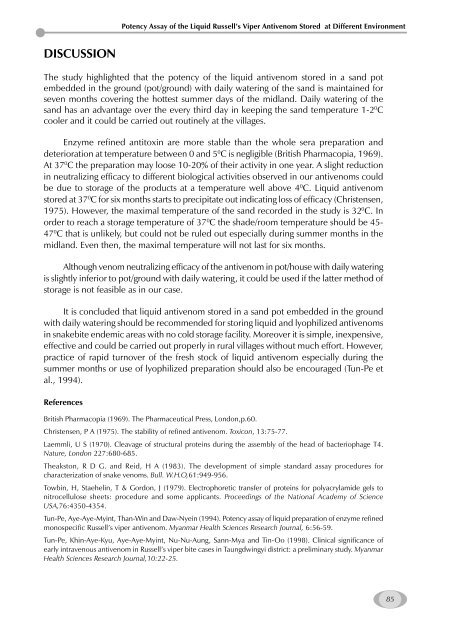Management of Snakebite and Research Management of Snakebite ...
Management of Snakebite and Research Management of Snakebite ...
Management of Snakebite and Research Management of Snakebite ...
Create successful ePaper yourself
Turn your PDF publications into a flip-book with our unique Google optimized e-Paper software.
DISCUSSION<br />
The study highlighted that the potency <strong>of</strong> the liquid antivenom stored in a s<strong>and</strong> pot<br />
embedded in the ground (pot/ground) with daily watering <strong>of</strong> the s<strong>and</strong> is maintained for<br />
seven months covering the hottest summer days <strong>of</strong> the midl<strong>and</strong>. Daily watering <strong>of</strong> the<br />
s<strong>and</strong> has an advantage over the every third day in keeping the s<strong>and</strong> temperature 1-2 0 C<br />
cooler <strong>and</strong> it could be carried out routinely at the villages.<br />
Enzyme refined antitoxin are more stable than the whole sera preparation <strong>and</strong><br />
deterioration at temperature between 0 <strong>and</strong> 5 0 C is negligible (British Pharmacopia, 1969).<br />
At 37 0 C the preparation may loose 10-20% <strong>of</strong> their activity in one year. A slight reduction<br />
in neutralizing efficacy to different biological activities observed in our antivenoms could<br />
be due to storage <strong>of</strong> the products at a temperature well above 4 0 C. Liquid antivenom<br />
stored at 37 0 C for six months starts to precipitate out indicating loss <strong>of</strong> efficacy (Christensen,<br />
1975). However, the maximal temperature <strong>of</strong> the s<strong>and</strong> recorded in the study is 32 0 C. In<br />
order to reach a storage temperature <strong>of</strong> 37 0 C the shade/room temperature should be 45-<br />
47 0 C that is unlikely, but could not be ruled out especially during summer months in the<br />
midl<strong>and</strong>. Even then, the maximal temperature will not last for six months.<br />
Although venom neutralizing efficacy <strong>of</strong> the antivenom in pot/house with daily watering<br />
is slightly inferior to pot/ground with daily watering, it could be used if the latter method <strong>of</strong><br />
storage is not feasible as in our case.<br />
It is concluded that liquid antivenom stored in a s<strong>and</strong> pot embedded in the ground<br />
with daily watering should be recommended for storing liquid <strong>and</strong> lyophilized antivenoms<br />
in snakebite endemic areas with no cold storage facility. Moreover it is simple, inexpensive,<br />
effective <strong>and</strong> could be carried out properly in rural villages without much effort. However,<br />
practice <strong>of</strong> rapid turnover <strong>of</strong> the fresh stock <strong>of</strong> liquid antivenom especially during the<br />
summer months or use <strong>of</strong> lyophilized preparation should also be encouraged (Tun-Pe et<br />
al., 1994).<br />
References<br />
Potency Assay <strong>of</strong> the Liquid Russell’s Viper Antivenom Stored at Different Environment<br />
British Pharmacopia (1969). The Pharmaceutical Press, London,p.60.<br />
Christensen, P A (1975). The stability <strong>of</strong> refined antivenom. Toxicon, 13:75-77.<br />
Laemmli, U S (1970). Cleavage <strong>of</strong> structural proteins during the assembly <strong>of</strong> the head <strong>of</strong> bacteriophage T4.<br />
Nature, London 227:680-685.<br />
Theakston, R D G. <strong>and</strong> Reid, H A (1983). The development <strong>of</strong> simple st<strong>and</strong>ard assay procedures for<br />
characterization <strong>of</strong> snake venoms. Bull. W.H.O,61:949-956.<br />
Towbin, H, Staehelin, T & Gordon, J (1979). Electrophoretic transfer <strong>of</strong> proteins for polyacrylamide gels to<br />
nitrocellulose sheets: procedure <strong>and</strong> some applicants. Proceedings <strong>of</strong> the National Academy <strong>of</strong> Science<br />
USA,76:4350-4354.<br />
Tun-Pe, Aye-Aye-Myint, Than-Win <strong>and</strong> Daw-Nyein (1994). Potency assay <strong>of</strong> liquid preparation <strong>of</strong> enzyme refined<br />
monospecific Russell’s viper antivenom. Myanmar Health Sciences <strong>Research</strong> Journal, 6:56-59.<br />
Tun-Pe, Khin-Aye-Kyu, Aye-Aye-Myint, Nu-Nu-Aung, Sann-Mya <strong>and</strong> Tin-Oo (1998). Clinical significance <strong>of</strong><br />
early intravenous antivenom in Russell’s viper bite cases in Taungdwingyi district: a preliminary study. Myanmar<br />
Health Sciences <strong>Research</strong> Journal,10:22-25.<br />
85









